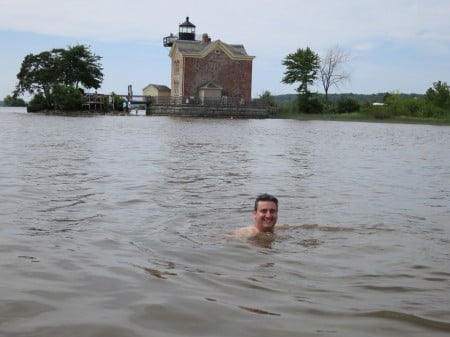Science Q&A on Antibiotic-Resistant Bacteria in the Hudson
This is a short question-and-answer session that Riverkeeper boat captain John Lipscomb had with Greg O’Mullan, of Queens College, a partner in Riverkeeper’s ongoing Hudson River water quality monitoring program, and the corresponding author of “Antibiotic-resistant bacteria in the Hudson River Estuary linked to wet weather sewage contamination,” the study that has recently received extensive coverage in the press. (Also see the authors’ description of the study and why it matters (pdf). To read Riverkeeper’s perspective on the study, please see, Swim in the Hudson River—But Swim Smart.)
Why did you choose to conduct this study?
My laboratory studies bacterial water and air quality, focusing mostly on the Hudson River Estuary and urban environments. In recent years we have participated in water quality monitoring in the Hudson using EPA-approved sewage indicators, like Enterococcus, that do not themselves present a major health risk but are used to predict the abundance of other pathogens. We thought it was important to determine to what extent the levels of Enterococci in Hudson River water predicted the abundance of other microbial agents of concern—such as antibiotic-resistant bacteria. In addition, antibiotic-resistant bacteria are a growing concern across the nation and we wanted to learn more about the ecology of these bacteria in the environment.
Why was this study important? What did you find?
Most importantly, the study’s results confirm that the abundance of antibiotic-resistant bacteria in the Hudson are connected to sewage pollution and that the levels of these bacteria increased following rainfall, presumably due to the release of untreated sewage through Combined Sewer Overflows (CSOs). Many of the antibiotic-resistant bacteria were similar to microbes known to occur in the human intestine and, in some cases, they were associated with genera known to contain opportunistic pathogens.
The correlated abundance of antibiotic-resistant bacteria and Enterococci—the commonly used sewage indicating bacteria—strongly supports the value of water quality monitoring programs like the Riverkeeper sampling program and the DEP Harbor monitoring program. The study also provides additional motivation to reduce sewage pollution and to invest in infrastructure that will result in cleaner water.
Do you think this means that we shouldn’t swim in the Hudson?
It’s really not that simple. The water quality varies a lot in both space and in time. I do think that it is important to consider the risks and to be an educated recreator. Having studied the river for a number of years there are places (near CSO outfalls or wastewater treatment outfalls) and times (especially following rain) that I would avoid contact. But there are also lots of places where I would swim and where I have swum. Last week I swam in the river near Saugerties (see picture below). It was a hot day and it felt great to get into the river. And I wasn’t the only one swimming there; within sight there were a bunch of kids and their parents swimming off the Saugerties Lighthouse. It’s really an individual decision, but until we eliminate sewage pollution from the river it is important to gather as much information as you can to make an informed decision.

Gregory O'Mullan, a co-author of the antibiotic-resistant bacteria study, enjoying a swim in the Hudson near Saugerties during the recent heat wave.
This study has received a lot of press, some of it suggesting that the study would indicate the river is more polluted than ever. What does this study mean for the health of the Hudson?
It’s not like the findings from this study have actually changed water quality one way or the other… maybe some people’s perception of water quality, but the bacteria in the river don’t read scientific journals or care all that much about what I have to say. In the places where long term water quality data exist—like in New York Harbor—there is convincing evidence that water quality has improved substantially in recent decades. There are many reasons to be optimistic and to be proud of the progress being made. However, sewage continues to be dumped into the river and we should remain concerned about water quality. This study shouldn’t be a reason for giving up on the Hudson, but maybe it can be a wake up call to keep pushing for improvements in water quality.
